Cacao on Kauai: A Journey to the North Pole of Chocolate
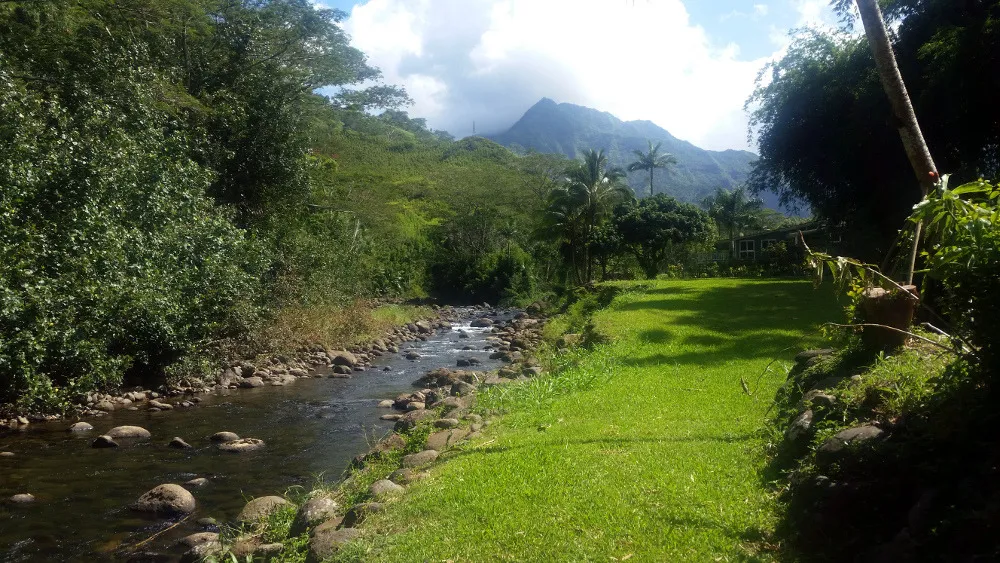
I always tell customers that we’re fortunate to live in the US because we have the ability to grow cacao here. Okay, only in Hawaii and Puerto Rico, but still, we have something our chocolate-consuming brethren in Europe don’t – our own tropical climate.
When you talk to a cacao farmer/chocolate maker in Hawaii, they begin to distinguish by island. It’s a valid conversation, but from an outsider’s perspective, it seems a bit like splitting hairs. But then, I’m not a cacao farmer or chocolate maker, so I expect that each degree closer to 20 degrees makes a big difference in your ability to successfully grow cacao and to effectively conduct post-harvest processing.
I once had a Hawaii chocolate maker from Oahu tell me that it’s “too cold to grow cacao on Kauai” which is the northernmost major island in Hawaii. Technically that’s true. Kauai sits at 22 degrees 05’N, while balmy Oahu is situated at 21 degrees 28’N to be exact. On my recent visit to the islands, an Oahu chocolate maker did admit that the Big Island had it much better. Just inside the tropical belt where cacao “officially” grows, the Big Island sits at 19 degrees 34’N.
I had the pleasure of visiting Kauai and Oahu a few weeks ago, and what I found in Hawaii was an excited and exciting chocolate community. There are cacao farms dotting the islands of Hawaii, a burgeoning bean-to-bar community and plenty of research and support from the academic community. I had the opportunity to meet one of a few cacao farmers on Kauai who are proving it is possible to grow cacao and to make chocolate on this northernmost island.
My cacao journey on Kauai began when I remembered that I had a chocolate contact on the island. While I had planned to visit my cacao and chocolate friends on Oahu, I had not given much thought to chocolate on Kauai. My love of swimming in tropical waters matches my love of chocolate, so my planning for Kauai was focused on water and hiking activities. As I got ready to board the plane, I suddenly remembered that Katie Ranke of The Slow Melt lives on Kauai. I dashed off a quick email to Katie, and when I arrived in Kauai I had her response along with links to places I might want to visit. Among those places were Garden Island Chocolate, Steelgrass Farm, and Chocolat Hanalei.
We were staying closest to Hanalei, so I decided to check out Chocolat Hanalei. Owned by a couple named Jack and Irmgard (I still don’t know their last names), Chocolat Hanalei opened for business in 2015. They have a charming store in town, and a beautiful shangri-la of a property between Hanalei and Haena State Park. You can see the vista in the photo at the top of this article. It’s a stunningly beautiful property with Kauai’s majestic moutains in the background and tall tropical trees waving in the breeze. There are at least two small plots planted with cacao trees that are a few years old. At the time of our visit, the trees had tiny pods on them, some of them shiny and red, others black with rot. I later learned from Seneca Klassen that this was normal, and it was the tree’s way of culling the pods to a number it can support.
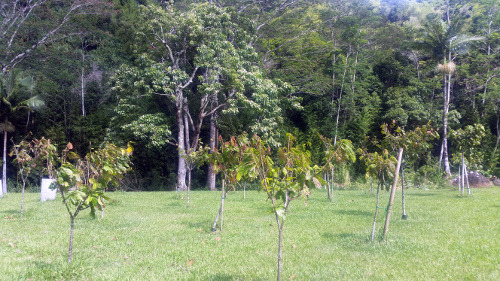
Irmgard and Jack planted cacao trees with assistance from Dan O’Doherty. Jack told me that they had planted a number of varietals and that those varietals had already crossed, so there’s genetic diversity among their crop. They have been harvesting enough cacao to make 40-50 bean-to-bar chocolates each year. The chocolates sell for $11/bar, and the locals immediately buy the chocolate. So there was no chocolate for me to taste – well none of their bean-to-bar chocolate.
When not selling their own bean-to-bar chocolate, Irmgard is busy making chocolate bonbons and dipping local fruits in Guittard chocolate. She does this in an air-conditioned commercial kitchen that sits on the property, which you can see below.
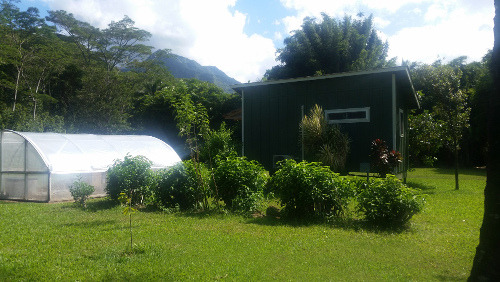
Irmgard is rightfully proud of using as many local ingredients as possible, and when you live in Hawaii, why wouldn’t you? We tasted candied ginger, dried papaya and dried mango dipped in chocolate before she proffered a white chocolate lilikoi (e.g., passionfruit) ganache in a dark chocolate shell. It was a mouthwatering slice of Hawaii’s best covered in chocolate.
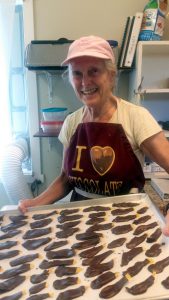
Chocolat Hanalei has a charming shop in town that befits the local atmosphere. It’s a tiny, walk-in shop with a counter inside. It’s too nice to be called a shack, but it’s pretty close in size. The first time I stopped there I completely missed the two cacao trees flanking the patio. It’s not often I have the pleasure of visiting a chocolate shop that has its own cacao trees planted in the ground outside its doors. There’s a bench with the word “chocolate” painted across the back, and it is conveniently located on a shaded porch where you can consume your chocolate away from the bright sunlight while enjoying a book from the free private library.
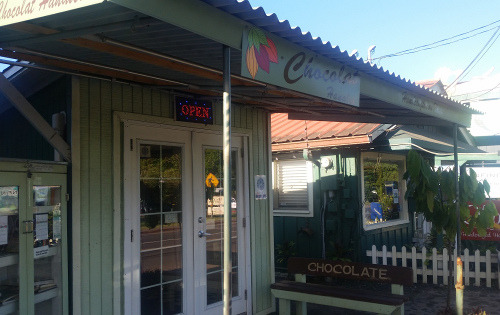
Much as I love cacao and chocolate, I limited myself to one cacao farm visit on Kauai. I knew I would be geeking out on cacao when I got to Oahu in a few days, so this was my time to swim as much as possible. I did not make it to the other farms, but there are at least two others on Kauai that are successfully growing cacao and making chocolate. Garden Island Chocolate offers tours for a fee, and they sell their bars at their own stand and in a number of local stores. Steelgrass Farm also offers tours for a fee along with an 11-flight chocolate tasting that includes both their own, single-estate bar along with bars from other Hawaiian chocolate makers and by Valrhona, Kallari and other well-known names.
Next up I’ll be sharing my visits on Oahu, including a visit to Seneca Klassen’s cacao farm, a quick stop at Manoa Chocolate and a visit to Madre’s shop in Oahu. Stay tuned for more tales of Hawaii cacao.